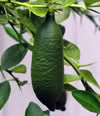| Author |
Message |
David
Citruholic

Joined: 26 Jun 2008
Posts: 136
Location: Livingston Louisiana
|
| Posted: Mon 08 Dec, 2008 8:08 pm |
|
I am finding that there are many different types of the Poncirus Trifoilata that grow wild here in South Louisiana. I have found trees that grow bitter and smelly ornages. I have found them with lots of fuzz on them and chock full of seed...sometimes as much as 55 seed in them. I have found trees with no fuzz and quite juicy.....I doubted this was trifoilata at first but..............upon comparing the taste, the seed, the smell and the study of the offspring it is............... I guess it is much like the rest of the plants...left to their own design they will do what they need to do to survive and replicate.............it is interesting though. David |
|
| Back to top |
|
 |
Laaz
Site Owner


Joined: 12 Nov 2005
Posts: 5642
Location: Dorchester County, South Carolina
|
| Posted: Tue 09 Dec, 2008 12:05 am |
|
I think you are finding Citrange trees, which look a lot like Trifoliata, but the fruit has a smooth shiny texture.
_________________
Wal-Mart a great place to buy cheap plastic crap ! http://walmartwatch.com/ ...
 |
|
| Back to top |
|
 |
David
Citruholic

Joined: 26 Jun 2008
Posts: 136
Location: Livingston Louisiana
|
| Posted: Tue 09 Dec, 2008 12:19 am |
|
I tired hard to make this not a trifoilata bu I am pretty sure that it is. In the citranges the center leaf is longer and bigger than the two on the side. The seedlings from this one are just exactly like PT...you can not tell them from a standard fuzzy smelly PT. I have seen the citranges...Troyer and Carrizo and the citrimelo and sour ornage and this is not any of them. This fruit is not a good tasting fruit..it has the trifoilata bad taste to it. It is not as pronounced as in the fuzzy PT but its still there. I can post a pic but it is just going to be a pic much like a small PT without fuzz. I have found the small citrange.....but this is not one of them either........................ |
|
| Back to top |
|
 |
A.T. Hagan
Moderator


Joined: 14 Dec 2005
Posts: 898
Location: Gainesville, Florida, United States, Earth - Sol III
|
| Posted: Thu 11 Dec, 2008 3:49 pm |
|
Given a sufficiently large population of a given species that is naturally reproducing itself I'd have no problem believing you are finding variation within that population. There's no one out there selecting for particular characteristics so natural evolution is doing it.
.....Alan. |
|
| Back to top |
|
 |
JoeReal
Site Admin


Joined: 16 Nov 2005
Posts: 4726
Location: Davis, California
|
| Posted: Thu 11 Dec, 2008 4:03 pm |
|
you meant natural selection pressure.... Evolution in citruses is just too slow to observe for us given the life span of the citrus species and our life span, unless we throw in some hormones, GMO introduction and other manmade chemicals that causes genetic distortions, I meant, variations.... |
|
| Back to top |
|
 |
citrange
Site Admin


Joined: 24 Nov 2005
Posts: 589
Location: UK - 15 miles west of London
|
| Posted: Thu 11 Dec, 2008 6:25 pm |
|
It is interesting that both the US Riverside citrus collection and the French INRA collection in Corsica have many different Poncirus selections. However, I have never been able to find detailed descriptions of their differences. I suspect this is because they probably all perform similarly as commercial rootsocks, which is the basic interest of these organisations.
I have observed great differences in the fruit from different trees in different locations, and also from the same tree in different years. In England, fruits tend to be very thick-skinned with warty, bumpy, corrugated fruit, sometimes with a large 'nipple' end and sometimes even navel like. They are often seedless and quite juicy. In comparison, I saw fruits in Beijing this year that were absolutely ping-pong ball spherical. Whether this is entirely due to environment, or there is a genetic variation, I have no idea. |
|
| Back to top |
|
 |
A.T. Hagan
Moderator


Joined: 14 Dec 2005
Posts: 898
Location: Gainesville, Florida, United States, Earth - Sol III
|
| Posted: Thu 11 Dec, 2008 6:38 pm |
|
| JoeReal wrote: | | you meant natural selection pressure.... Evolution in citruses is just too slow to observe for us given the life span of the citrus species and our life span, unless we throw in some hormones, GMO introduction and other manmade chemicals that causes genetic distortions, I meant, variations.... |
Is not selection pressure what natural evolution is? We seem to be saying the same thing using different phrases.
.....Alan. |
|
| Back to top |
|
 |
JoeReal
Site Admin


Joined: 16 Nov 2005
Posts: 4726
Location: Davis, California
|
| Posted: Thu 11 Dec, 2008 7:04 pm |
|
| A.T. Hagan wrote: | | JoeReal wrote: | | you meant natural selection pressure.... Evolution in citruses is just too slow to observe for us given the life span of the citrus species and our life span, unless we throw in some hormones, GMO introduction and other manmade chemicals that causes genetic distortions, I meant, variations.... |
Is not selection pressure what natural evolution is? We seem to be saying the same thing using different phrases.
.....Alan. |
Alan, I don't disagree with what you're leading to. It is a matter of time scale. Evolution would really involve speciation event where one species evolves from the same line. Many generation of selection pressures will normally have to happen before a new species is evolved. What we are observing right now are the various natural selection pressure within our generation scale that would at best lead to different cultivars and not species, depending upon the type of selection pressure.
In plant breeding, we are the ones doing the genetic manipulation and the selection pressure (after evaluation of their performances). In Genetic Engineering, we are doing the manipulation (interspecific hybridization, irradiation, chemical and physical stresses, gene splicing, cross species gene transfer inclduing from bacteria or animals, etc), forming radically new cultivars or even species, which we also evaluate and select from the various combos that we make. |
|
| Back to top |
|
 |
pagnr
Citrus Guru

Joined: 23 Aug 2008
Posts: 407
Location: Australia
|
| Posted: Sun 14 Dec, 2008 10:10 am |
|
Recently visited a young orange grove, using Trifoliata rootstock. Quite a few had fruiting suckers, showing a fair variation of fruit types between plants,
ie,small ribbed, round, rough peel, smoother peel etc etc , but all obviously Trifoliata. I'm fairly sure all rootstocks have been propogated from the one rootstock seed source, so all the variation is within that strain.
Also a recent seed bulletin here, claimed that Trifoliata was subject to genetic mutation, induced by Pythium infection, causing visibly off type rootstocks in seedbeds. This explained a high level of small slow growing off types appearing from certified seed. Perhaps these could produce more widely varying fruit if they ever matured ?
The Flying Dragon Trifoliata strain seems to produce a % of straight trunked and/or straight thorned types, some of which seem more or less edible ,or at least far better than the average Tri. |
|
| Back to top |
|
 |
yuzuquat
Citruholic

Joined: 01 Sep 2013
Posts: 114
Location: manchester, england
|
| Posted: Wed 16 Oct, 2013 6:56 pm |
|
Poncirus in its natural environment is much more variable than we know in the west.
There are several varieties that were recognised by the plant collectors e.g. punctata with spotted leaves.
Flying dragon is a natural sport.
The genetic pool of poncirus in the west is very narrow i.e. all closely related and probably descended from very few plants.
Supposedly in china there is a poncirus thst does not produce poncirin.
A hardy citrus without bitter oil that coulf be crossed with mandarin and have good chance of producing ediblr fruit.
No chance of seeing it until greening is sorted out by which time will probably be something else. |
|
| Back to top |
|
 |
ilyaC
Citruholic


Joined: 04 Sep 2009
Posts: 274
Location: France, 40km South of Paris
|
| Posted: Wed 16 Oct, 2013 7:21 pm |
|
| yuzuquat wrote: |
Supposedly in china there is a poncirus thst does not produce poncirin.
. |
In this case , it is strange, that Chinese never produced any poncirus based edible hybrid.
_________________
Best regards,
Ilya |
|
| Back to top |
|
 |
bussone
Citruholic

Joined: 30 Apr 2013
Posts: 68
Location: Philadelphia, PA, USA
|
| Posted: Wed 16 Oct, 2013 7:40 pm |
|
| yuzuquat wrote: |
Supposedly in china there is a poncirus thst does not produce poncirin.
|
I'm familiar enough with the history of tea to be dubious of any claim that starts with "Supposedly in china." |
|
| Back to top |
|
 |
buddinman
Citrus Guru

Joined: 15 Nov 2005
Posts: 342
Location: Lumberton Texas zone 8
|
| Posted: Thu 17 Oct, 2013 1:40 pm |
|
There are a number of high quality satsuma varieties that originated in china. Some can be obtained from the CCCP. For out of state buyers it is kind of pricy. |
|
| Back to top |
|
 |






















